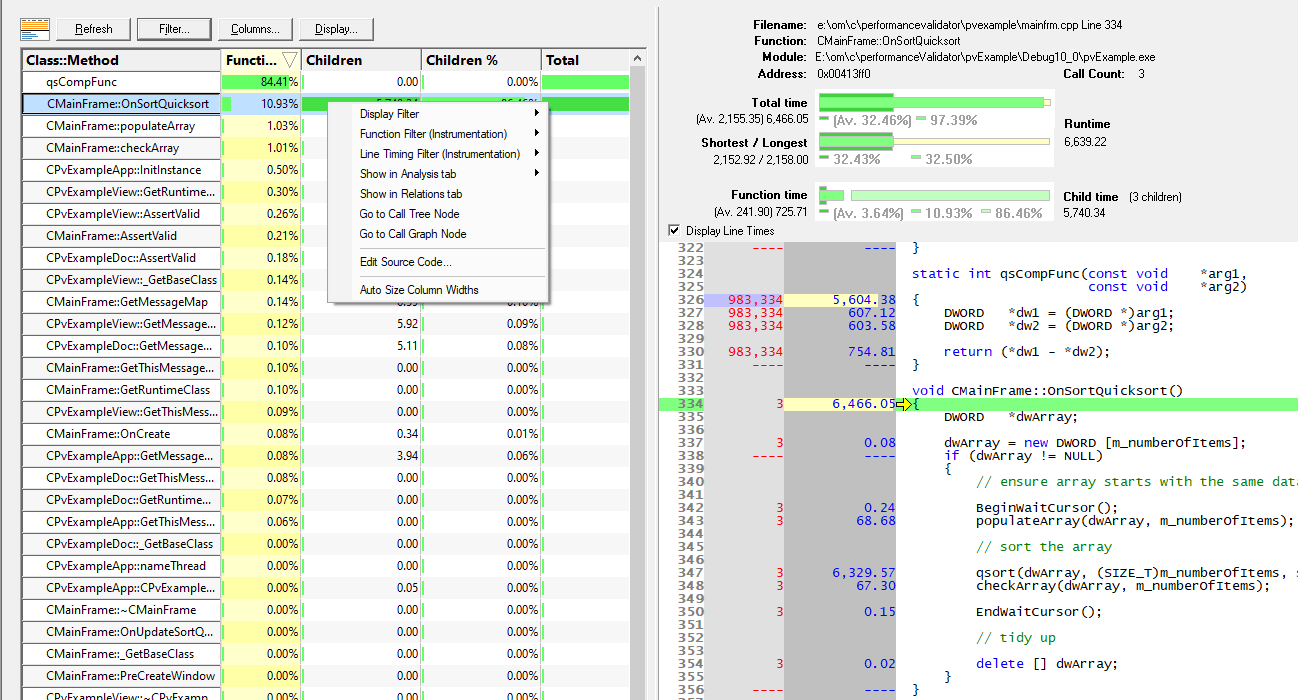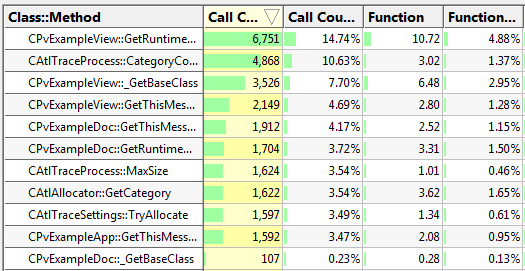The Statistics tab displays performance data about each function called by your program.
 Read on, or click a part of the image below to jump straight to the help for that area.
Read on, or click a part of the image below to jump straight to the help for that area.
As with many of the tab views, the display is split into two resizable panes.
•The table of statistics on the left has extensive performance data
The table's popup menu provides plenty of options to filter data or to examine more detail
•The right side shows the source code view for any function selected on the left
The statistics view
Performance data is shown for every function that has been hooked.
The default ordering of functions is by directory first, and then by the files in those directories.
The data can be otherwise sorted by any column and you can change the frequency with which the data is updated.
The amount of information displayed can be controlled by adding or removing columns or by filtering for specific areas of interest.
Double clicking any item will display the function on the Relations tab.
What data is available?
The Statistics view can show a large amount of performance related data, although not all of it is displayed by default.
The following table list all the available columns of data.
Attribute |
Description |
Shown by default |
•Class |
class name |
No |
•Method |
method name (or function name if no class) |
No |
•Class::Method |
class::method name (or function name if no class) |
Yes |
•Address |
function address |
Yes if sampling |
•Num Children |
number of child functions of a function |
No |
•Av Func •Av Func % |
average time a function takes to execute (excludes child functions) |
No |
•Av Total •Av Total % |
average total time a function takes to execute, including its children |
No |
•Call Count •Call Count % |
number of times the function is called |
Yes |
•Function •Function % |
the time a function takes to execute (excludes child functions) |
Yes |
•Children •Children % |
the time a function's child functions take to execute |
Yes |
•Total •Total % |
the time a function and its child functions take to execute |
Yes |
•Longest •Longest % |
the longest time a function and its child functions take to execute |
|
•Shortest •Shortest % |
the shortest time a function and its child functions take to execute |
|
•Sample Count •Sample Count % |
the number of times a function is found in the sampled data |
Yes |
•Module |
name of the module containing the function |
Yes |
•Filename |
name of the file containing the function |
Yes |
Items in green are not available in Sampling data collection mode as the yellow Sample Count columns are substituted instead.
Percentage values are relative to the total run time or total number of calls made to all functions.
 You may not need all this information - see the section on changing which columns are displayed.
You may not need all this information - see the section on changing which columns are displayed.
Percentage bars
All the cells in the table that show numerical data have a percentage bar indicating one of the following:
•the function's value relative to the maximum value in the column
e.g. Call Count in the example below
•the function's percentage contribution to the total
e.g. Call Count %, or Function time, below
Window orientation
To adapt to your screen layout, the horizontal or vertical orientation of the statistics and source code panes can be toggled with the orientation button.


Updating the display
•Display...  display the Statistics display dialog, which controls the auto-updating of the display.
display the Statistics display dialog, which controls the auto-updating of the display.
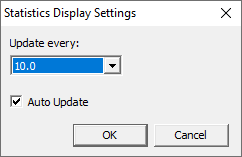
•Auto update...  switch the automatic updating on or off - see the next option
switch the automatic updating on or off - see the next option
•...every N seconds  automatically updates the display at your choice of interval, from 1.0 to 60 seconds
automatically updates the display at your choice of interval, from 1.0 to 60 seconds
Adjust this depending on the complexity of your application.
An update interval that is too short may mean Performance Validator spends too much time updating the display.
•Refresh  updates the display - as does the
updates the display - as does the  button on the Tools menu and toolbar
button on the Tools menu and toolbar
With auto update off, you'll need to use this Refresh button to update the display when you wish.
•Do not scroll first column  optionally keep the first column fixed when scrolling the table horizontally
optionally keep the first column fixed when scrolling the table horizontally
Unless you changed the visible columns, or reordered them, the first column will typically be Class::Method.
Sorting the data
You can sort the data in the table by clicking in the table header.
 Note that while your application is executing, the sorted data is live. Sorting may not complete correctly as the data may change during the sort. Only when your program has finished executing is the sorted data guaranteed accurate.
Note that while your application is executing, the sorted data is live. Sorting may not complete correctly as the data may change during the sort. Only when your program has finished executing is the sorted data guaranteed accurate.
Managing the data being displayed
There are two ways to change what's displayed in the view.
•hide or show whole columns of data in the table
•filter out unwanted functions, or only show specific functions of interest
Changing which columns are displayed
The choice of which columns to display is the same on the Statistics and Relations tabs. In fact, you can choose to control columns in both areas from the same configuration dialog.
•Columns  shows the Configure Columns dialog for the Statistics view
shows the Configure Columns dialog for the Statistics view
If you're using a sampling method to collect statistics, you'll see the dialog on the right.
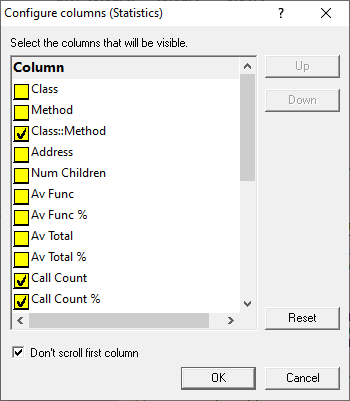
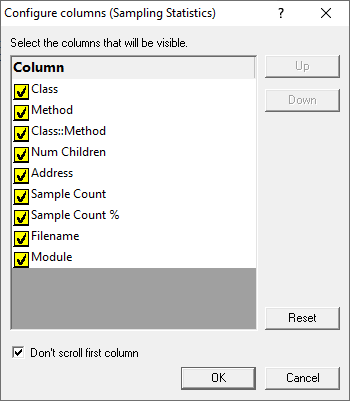
Check or uncheck which columns you want to show and hide.
•Up / Down  nudge a selected column name up or down in the list
nudge a selected column name up or down in the list
Columns at the top are displayed left-most in the table
•Reset  set the visibility and the order of columns back to their defaults
set the visibility and the order of columns back to their defaults
•Don't scroll first column  optionally keep the first column fixed when scrolling the table horizontally
optionally keep the first column fixed when scrolling the table horizontally
Unless you changed the visible columns, or reordered them, the first column will typically be Class::Method.
•Apply to all display tabs  if checked (default), the changes you make will affect both Statistics and Relations tabs
if checked (default), the changes you make will affect both Statistics and Relations tabs
Once configured, click OK to apply the changes.
Filtering statistics in the table
The 'display filters' affect which functions are hidden and shown in the data. They do not affect which functions are hooked in the first place.
•Filter  shows the Statistics Display Filter Manager:
shows the Statistics Display Filter Manager:
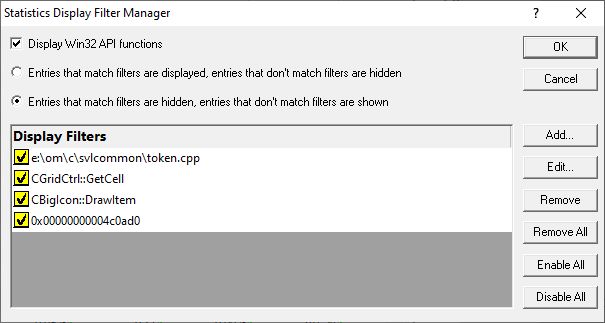
The dialog initially has no items in the list. Add some items manually or use the convenience filter options on the popup menu.
•Add...  displays the display filter dialog described below
displays the display filter dialog described below
•Edit...  opens the display filter dialog populated with the selected item's criteria, ready for editing
opens the display filter dialog populated with the selected item's criteria, ready for editing
Alternatively, just double click an entry in the list to show the filter dialog.
•Remove  remove selected filter(s) in the list
remove selected filter(s) in the list
•Remove All  remove all filters
remove all filters
•Enable All  enables all filters in the list
enables all filters in the list
•Disable All  disables all filters
disables all filters
You can also enable or disable individual items in the list via the yellow check box at the left of each row.
•Display Win32 API functions  if selected this displays Win32 API functions otherwise Win32 API functions are hidden
if selected this displays Win32 API functions otherwise Win32 API functions are hidden
•Entries that match filters are displayed  select this to display only matched items
select this to display only matched items
•Entries that match filters are hidden  select this to remove matched items from the display
select this to remove matched items from the display
 Take care when selecting Entries that match filters are displayed as clearing the list and leaving this checked will leave no functions being displayed at all!
Take care when selecting Entries that match filters are displayed as clearing the list and leaving this checked will leave no functions being displayed at all!
The Display Filter dialog
The dialog below allows you to create a filter based on matching one or more criteria.
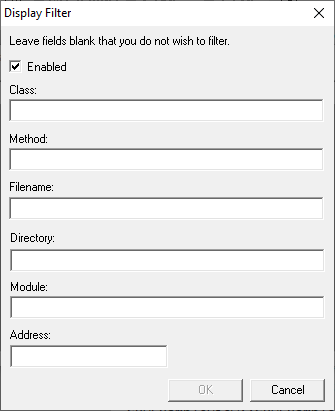
If you don't enter some of the details, they simply won't form part of the match criteria.
•Enabled  set this particular filter active or inactive
set this particular filter active or inactive
This is exactly equivalent to checking the listed item in the display filter manager.
•Class  enter the class name that the filter must match
enter the class name that the filter must match
If you enter a class but no method name then all functions in the class are filtered.
•Method  enter the method name
enter the method name
If you enter a method but no class then the filter will match the named function in any class.
•Filename  filter all functions in the specified file
filter all functions in the specified file
The full path to the file is required.
•Directory  filter all functions in the specified directory
filter all functions in the specified directory
The full directory path is required.
•Module  filter all functions in the specified module
filter all functions in the specified module
The full path to the module is required.
•Address  filter an exact address in memory
filter an exact address in memory
Finding text
To find text in the table of statistics, use the Find Dialog where you can search in any or all of the different columns.
 The source code view has its own Find and Goto dialogs.
The source code view has its own Find and Goto dialogs.
Statistics menu options
The following popup menu is available over the data area to add filters, examine relations or edit code.
Menu actions apply to the function for the row at the menu-click location.
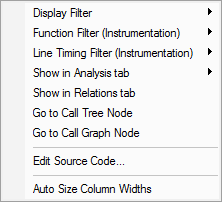
 Menu options: Display Filter
Menu options: Display Filter
The display filter sub-menu below provides a quick and convenient way to hide or show data based on attributes of the selected item.
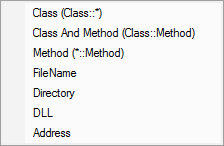
Choosing any of these options will add the filter to the Display Filter dialog.
For example:
•Class  hides all functions belonging to the same class
hides all functions belonging to the same class
•FileName  hides all functions that were in the same file
hides all functions that were in the same file
 These options work well for filtering out something you see in the display that you'd like to remove. You may not get the results you expect if the Display Filter dialog is set to have the filters inverted.
These options work well for filtering out something you see in the display that you'd like to remove. You may not get the results you expect if the Display Filter dialog is set to have the filters inverted.
 Menu options: Function filter (Instrumentation)
Menu options: Function filter (Instrumentation)
While the display filter controls visibility of hooked data, instrumentation filters control which functions are hooked in the first place.
The function instrumentation filter sub-menu lets you add hook filters at different levels of granularity.
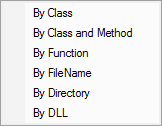
 The affect of adding function filters here depends on the current filter settings:
The affect of adding function filters here depends on the current filter settings:
•If the current filters are set to hook everything, adding new filters will switch to excluding newly selected hooks
•Otherwise, the current filter will be retained, i.e. hook or don't hook newly selected items
The first three options add filters to the Class and Function Filter Settings:
•By Class  adds a new filter, excluding the entire class from the results of subsequent sessions
adds a new filter, excluding the entire class from the results of subsequent sessions
•By Class and Method  excludes only the selected function from new sessions
excludes only the selected function from new sessions
•By Function  excludes all matching function names irrespective of their containing class or even if not in a class at all
excludes all matching function names irrespective of their containing class or even if not in a class at all
The next two, Filename and Directory, are part of the Source Files Filter settings.
•By FileName  adds a new filter, excluding all functions in the same file (as the selected item) from the results of subsequent sessions
adds a new filter, excluding all functions in the same file (as the selected item) from the results of subsequent sessions
•By Directory  excludes functions in all files in the same directory as the selected function
excludes functions in all files in the same directory as the selected function
Finally, the DLL level is controlled by the Hooked DLLs settings.
•By DLL  excludes functions in all files belonging to the same executable or DLL as the selected function
excludes functions in all files belonging to the same executable or DLL as the selected function
 Instrumentation filters become effective at the start of the next session. Adding a filter during a session will show the relevant rows in grey so that you can see which files would be filtered, but the performance data will continue to be included for the rest of the current session.
Instrumentation filters become effective at the start of the next session. Adding a filter during a session will show the relevant rows in grey so that you can see which files would be filtered, but the performance data will continue to be included for the rest of the current session.
 Menu options: Line timing filter (Instrumentation)
Menu options: Line timing filter (Instrumentation)
Line timing instrumentation filters control which lines are hooked for line timing and are independent of the function filters above.
 The affect of adding line timing filters here depends on the current line timing filter settings:
The affect of adding line timing filters here depends on the current line timing filter settings:
•If the current filters are set to hook everything, adding new filters will switch to only including newly selected hooks
Note that this is the opposite of function filters.
•Otherwise, the current filter will be retained, i.e. hook or don't hook newly selected items
The line timing instrumentation filter sub-menu lets you add hook filters at three different levels of granularity.
Each option add filters to the Line Timing Filter Settings:
•By Class  adds a new filter, appending the entire class in the line timing results of subsequent sessions
adds a new filter, appending the entire class in the line timing results of subsequent sessions
•By Class and Method  include only the selected function in the line timing of new sessions
include only the selected function in the line timing of new sessions
•By Function  includes all matching function names irrespective of their containing class or even if not in a class at all
includes all matching function names irrespective of their containing class or even if not in a class at all
 Instrumentation filters become effective at the start of the next session. Adding a filter during a session will show the relevant rows in grey so that you can see which files would be filtered, but the performance data will continue to be included for the rest of the current session.
Instrumentation filters become effective at the start of the next session. Adding a filter during a session will show the relevant rows in grey so that you can see which files would be filtered, but the performance data will continue to be included for the rest of the current session.
 Menu option: Show in Analysis tab
Menu option: Show in Analysis tab
The Analysis tab shows results of a query on the call tree based on the selected function and the criteria chosen from the menu:
•Show in Analysis tab  choose any item in the following sub-menu, to be switched to the Analysis tab
choose any item in the following sub-menu, to be switched to the Analysis tab
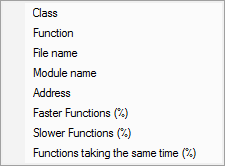
For example:
•Class  the Analysis tab will show all points in the call tree that match the class of the selected function
the Analysis tab will show all points in the call tree that match the class of the selected function
•File name  shows all points in the call tree that match the file name of the selected function
shows all points in the call tree that match the file name of the selected function
•Slower Functions (%)  shows all functions that are slower than the selected function
shows all functions that are slower than the selected function
 Menu options: Show in other tabs
Menu options: Show in other tabs
•Show in Relations tab  switch to the Relations tab where you can examine functions that either call, or are called by, the selected function
switch to the Relations tab where you can examine functions that either call, or are called by, the selected function
Double clicking any item will also display it in the Relations tab.
•Go to Call Tree Node  switch to the Call Tree view where the display will be expanded to show the first match found for the selected function
switch to the Call Tree view where the display will be expanded to show the first match found for the selected function
•Go to Call Graph Node  switch to the Call Graph view where the display will be expanded to show the first match found for the selected function
switch to the Call Graph view where the display will be expanded to show the first match found for the selected function
 Menu option: editing source code
Menu option: editing source code
•Edit Source Code...  opens the default or preferred editor to edit the source code
opens the default or preferred editor to edit the source code
 Menu option: column widths
Menu option: column widths
•Auto size column widths  sets the width of each column in the table appropriate to the content within
sets the width of each column in the table appropriate to the content within
The file source code view
Clicking on a function in the statistics table shows that function's source code file in the right hand pane.
The source code view is described in detail separately as its behaviour is the same for all views.
